#3D-bounding-box-annotation
Explore tagged Tumblr posts
Text
https://pixelannotation.com/3d-bounding-box-annotation/
0 notes
Text
Title: Image Annotation Services Explained: Tools, Techniques & Use Cases
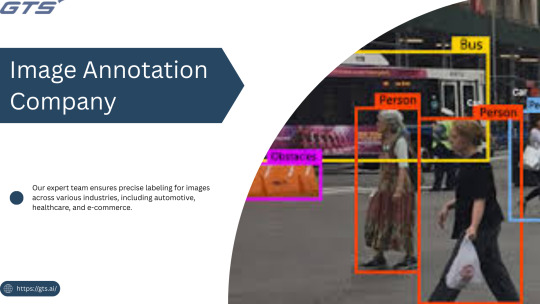
Introduction
In the fast-paced realm of artificial intelligence, Image Annotation Company serve as the foundation for effective computer vision models. Whether you are creating a self-driving vehicle, an AI-driven medical diagnostic application, or a retail analytics solution, the availability of high-quality annotated images is crucial for training precise and dependable machine learning models. But what precisely are image annotation services, how do they function, and what tools and methodologies are utilized? Let us explore this in detail.
What Is Image Annotation?
Image annotation refers to the practice of labeling or tagging images to facilitate the training of machine learning and deep learning models. This process includes the identification of objects, boundaries, and features within images, enabling AI systems to learn to recognize these elements in real-world applications. Typically, this task is carried out by specialized image annotation firms that employ a combination of manual and automated tools to guarantee precision, consistency, and scalability.
Common Image Annotation Techniques
The appropriate annotation method is contingent upon the specific requirements, complexity, and nature of the data involved in your project. Among the most prevalent techniques are:
Bounding Boxes:
Utilized for identifying and localizing objects by encasing them in rectangular boxes, this method is frequently applied in object detection for autonomous vehicles and security systems.
Polygon Annotation:
Best suited for objects with irregular shapes, such as trees, buildings, or road signs, this technique allows for precise delineation of object edges, which is essential for detailed recognition tasks.
Semantic Segmentation:
This approach assigns a label to every pixel in an image according to the object class, commonly employed in medical imaging, robotics, and augmented/virtual reality environments.
Instance Segmentation:
An advancement over semantic segmentation, this method distinguishes between individual objects of the same class, such as recognizing multiple individuals in a crowd.
Keypoint Annotation:
This technique involves marking specific points on objects and is often used in facial recognition, human pose estimation, and gesture tracking.
3D Cuboids:
This method enhances depth perception in annotation by creating three-dimensional representations, which is vital for applications like autonomous navigation and augmented reality.
Popular Image Annotation Tools
Image annotation can be executed utilizing a diverse array of platforms and tools. Notable examples include:
LabelImg: An open-source tool designed for bounding box annotations,
CVAT: A web-based application created by Intel for intricate tasks such as segmentation and tracking,
SuperAnnotate: A robust tool that merges annotation and collaboration functionalities,
Labelbox: A comprehensive platform featuring AI-assisted labeling, data management, and analytics,
VGG Image Annotator (VIA): A lightweight tool developed by Oxford for efficient annotations.
Prominent annotation service providers like GTS.AI frequently employ a blend of proprietary tools and enterprise solutions, seamlessly integrated with quality assurance workflows to fulfill client-specific needs.
Real-World Use Cases of Image Annotation
Image annotation services play a vital role in various sectors, including:
Autonomous Vehicles
Object detection for identifying pedestrians, vehicles, traffic signs, and road markings.
Lane detection and semantic segmentation to facilitate real-time navigation.
Healthcare
Annotating medical images such as X-rays and MRIs to identify tumors, fractures, or other abnormalities.
Training diagnostic tools to enhance early disease detection.
Retail and E-commerce:
Implementing product identification and classification for effective inventory management.
Monitoring customer behavior through in-store camera analytics.
Agriculture:
Assessing crop health, detecting pests, and identifying weeds using drone imagery.
Forecasting yield and optimizing resource allocation.
Geospatial Intelligence:
Classifying land use and mapping infrastructure.
Utilizing annotated satellite imagery for disaster response.
Why Work with a Professional Image Annotation Company?
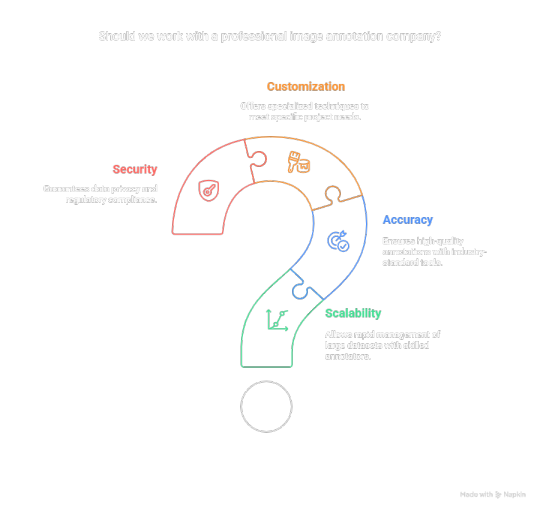
Although in-house annotation may initially appear feasible, expanding it necessitates significant time, resources, and a comprehensive quality assurance process. This is the reason businesses collaborate with providers such as GTS.AI:
Scalability : Allows for the rapid management of extensive datasets through skilled annotators;
Accuracy : Is ensured with industry-standard tools and quality assurance measures;
Customization : Coffers specialized annotation techniques to meet specific project objectives; and
Security : Guarantees adherence to data privacy regulations for sensitive data.
Final Thoughts
With the expansion of AI and computer vision applications, the necessity for high-quality annotated data has become increasingly vital. Image annotation services have evolved from being merely supportive functions to becoming strategic assets essential for developing dependable AI systems. If you aim to enhance your AI projects through professional data labeling, consider Globose Technology Solution .AI’s Image and Video Annotation Services to discover how they can effectively assist you in achieving your objectives with accuracy, efficiency, and scalability.
0 notes
Text
Video Annotation Services: Enhancing AI with Superior Training Data
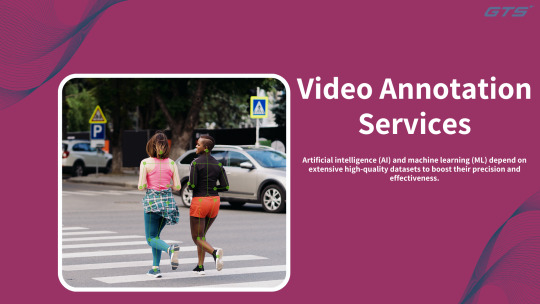
Introduction:
Artificial intelligence (AI) and machine learning (ML) depend on extensive high-quality datasets to boost their precision and effectiveness. A vital aspect of this endeavor is Video Annotation Services, a method employed to label and categorize various objects, actions, and events within video content. By supplying AI models with meticulously annotated video data, organizations can refine their AI solutions, rendering them more intelligent and dependable.
What is Video Annotation?
Video annotation refers to the process of appending metadata to video frames to facilitate the training of AI and ML algorithms. This process includes tagging objects, monitoring movements, and supplying contextual information that aids AI systems in comprehending and interpreting visual data. It is crucial for various applications, including autonomous driving, medical imaging, security surveillance, and beyond.
The Importance of High-Quality Training Data
The performance of AI models is significantly influenced by the quality of the data utilized for training. Inaccurately labeled or subpar data can result in erroneous predictions and unreliable AI outcomes. High-quality video annotation guarantees that AI models can:
Precisely identify and categorize objects.
Monitor movements and interactions within a scene.
Enhance real-time decision-making abilities.
Minimize errors and reduce false positives.
Essential Video Annotation Techniques
Bounding Boxes – These are utilized to outline objects within a video frame using rectangular shapes.
Semantic Segmentation – This technique involves labeling each pixel in a frame to achieve precise object identification.
Polygon Annotation – This method creates accurate boundaries around objects with irregular shapes.
Keypoint and Landmark Annotation – This identifies specific points on objects, facilitating facial recognition and pose estimation.
3D Cuboid Annotation – This technique incorporates depth information for artificial intelligence models applied in robotics and augmented/virtual reality environments.
The Role of Video Annotation Services in Advancing AI Applications
Autonomous Vehicles
Video annotation plays a vital role in training autonomous vehicles to identify pedestrians, other vehicles, traffic signals, and road signs.
Healthcare and Medical Imaging
AI-driven diagnostic tools depend on video annotation to identify irregularities in medical scans and to observe patient movements.
Security and Surveillance
AI-enhanced surveillance systems utilize annotated videos to recognize suspicious behavior, monitor individuals, and improve facial recognition capabilities.
Retail and Customer Analytics
Retailers employ video annotation to study customer behavior, monitor foot traffic, and enhance store layouts.
Reasons to for Professional Video Annotation Services
Engaging expert video annotation services offers several advantages:
Enhanced Accuracy – Skilled annotators deliver meticulous data labeling, minimizing errors during AI training.
Scalability – Professional services are equipped to manage extensive datasets with ease.
Cost Efficiency – Outsourcing annotation tasks conserves time and resources by negating the necessity for internal annotation teams.
Tailored Solutions – Customized annotation methods designed for specific sectors and AI applications.
Your Reliable Partner for Video Annotation
At we offer premier video annotation services aimed at equipping AI with high-quality training data. Our expert team guarantees precise and scalable annotations across diverse industries, assisting businesses in developing more intelligent AI models.
Why Select video annotation
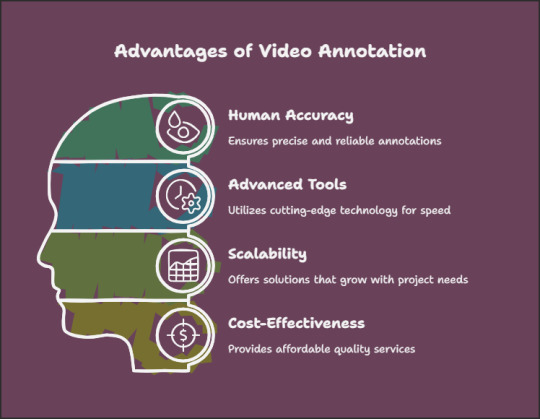
Proficient human annotators ensuring accuracy.
State-of-the-art annotation tools for expedited processing.
Scalable solutions customized to meet your project requirements.
Affordable pricing without sacrificing quality.
In Summary
Video annotation services are fundamental to AI training, ensuring that models are trained on high-quality, accurately labeled data. Whether your focus is on autonomous systems, healthcare AI, or security applications, investing in professional video annotation services like those offered by Globose Technology Solutions will significantly improve the accuracy and effectiveness of your AI solutions.
0 notes
Text
How Data Annotation Companies Improve AI Model Accuracy
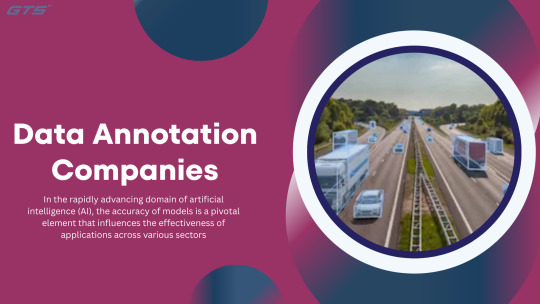
Introduction:
In the rapidly advancing domain of artificial intelligence (AI), the accuracy of models is a pivotal element that influences the effectiveness of applications across various sectors, including autonomous driving, medical imaging, security surveillance, and e-commerce. A significant contributor to achieving high AI accuracy is the presence of well-annotated data. Data Annotation Companies are essential in this process, as they ensure that machine learning (ML) models are trained on precise and high-quality datasets.
The Significance of Data Annotation for AI
AI models, particularly those utilizing computer vision and natural language processing (NLP), necessitate extensive amounts of labeled data to operate efficiently. In the absence of accurately annotated images and videos, AI models face challenges in distinguishing objects, recognizing patterns, or making informed decisions. Data annotation companies create structured datasets by labeling images, videos, text, and audio, thereby enabling AI to learn from concrete examples.
How Data Annotation Companies Enhance AI Accuracy
Delivering High-Quality Annotations
The precision of an AI model is closely linked to the quality of annotations within the training dataset. Reputable data annotation companies utilize sophisticated annotation methods such as bounding boxes, semantic segmentation, key point annotation, and 3D cuboids to ensure accurate labeling. By minimizing errors and inconsistencies in the annotations, these companies facilitate the attainment of superior accuracy in AI models.
Utilizing Human Expertise and AI-Assisted Annotation
Numerous annotation firms integrate human intelligence with AI-assisted tools to boost both efficiency and accuracy. Human annotators are tasked with complex labeling assignments, such as differentiating between similar objects or grasping contextual nuances, while AI-driven tools expedite repetitive tasks, thereby enhancing overall productivity.
Managing Extensive and Varied Data
AI models require a wide range of datasets to effectively generalize across various contexts. Data annotation firms assemble datasets from multiple sources, ensuring a blend of ethnic backgrounds, lighting conditions, object differences, and scenarios. This variety is essential for mitigating AI biases and enhancing the robustness of models.
Maintaining Consistency in Annotations
Inconsistent labeling can adversely affect the performance of an AI model. Annotation companies employ rigorous quality control measures, inter-annotator agreements, and review processes to ensure consistent labeling throughout datasets. This consistency is crucial to prevent AI models from being misled by conflicting labels during the training phase.
Scalability and Accelerated Turnaround
AI initiatives frequently necessitate large datasets that require prompt annotation. Data annotation firms utilize workforce management systems and automated tools to efficiently manage extensive projects, enabling AI developers to train models more rapidly without sacrificing quality.
Adherence to Data Security Regulations
In sectors such as healthcare, finance, and autonomous driving, data security is paramount. Reputable annotation companies adhere to GDPR, HIPAA, and other security regulations to safeguard sensitive information, ensuring that AI models are trained with ethically sourced, high-quality datasets.
Reasons to opt for a Professional Data Annotation Company
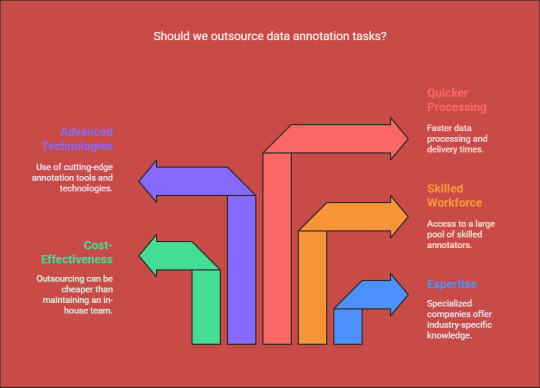
Outsourcing annotation tasks to a specialized company offers several benefits over relying on in-house teams:
Expertise in specific industry annotations
Cost-effective alternatives to establishing an internal annotation team
Access to a skilled workforce and advanced annotation technologies
Quicker data processing and delivery
Conclusion
Data annotation companies are essential for enhancing the accuracy of Globose Technology Solutions AI models through the provision of high-quality, meticulously labeled training datasets. Their proficiency in managing extensive, varied, and intricate annotations greatly boosts model performance, thereby increasing the reliability and effectiveness of AI applications. Collaborating with a professional annotation service provider enables businesses to expedite their AI development while maintaining optimal precision and efficiency.
0 notes
Text
Video Annotation: Empowering AI with Actionable Visual Data
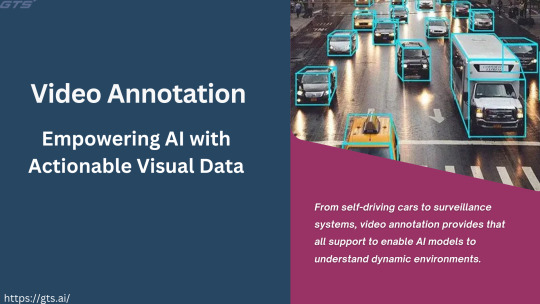
It is the known truth that AI thrives on data, and with computer vision, video data assumes center stage. But just any raw video footage is not what you want for training machine learning models involving recognition of intricate visual environments. This is where video annotation slowly comes into play-dictating the means of converting unstructured video content into actionable labeled data that completes the loop of AI-based applications.
From self-driving cars to surveillance systems, video annotation provides that all support to enable AI models to understand dynamic environments. In this article, we'll explore what video annotation is about, its process, challenges, and how it can change the AI landscape.
What is Video Annotation?
Video annotation is the method of tagging a video with meaningful metadata that lets machine learning models identify, predict, and even recognize objects, motions, or activities taking place in the video. This process allows AI systems to use video data within a real-life context when making interpretations.
Depending on the sophistication of the task, annotated videos may come in different forms, such as bounding boxes, polygons, key points, or semantic segmentation. These labels provide the AI with structured information that lets it learn how objects are spatially related, their trajectories, and the evolution of temporal relationships among video frames.
The Importance of Video Annotation in AI
Video annotation is vital for building a bridge between one piece of video footage and functional AI models. Here is why it is a necessary:
Enabling Object Detection and Tracking: Through annotated video data, AI models can actually identify and trace objects across different frames. Such ability is critical when creating and implementing such systems as self-driving cars, where the system should be able to observe a moving object such as a pedestrian, vehicles, and road signs all at once.
Improved Action Recognition: AI systems trained with annotated video data could identify and categorize every human activity. This opens new avenues for sports analysis, security, and even healthcare in areas like fall detection for elderly persons.
Enhanced Predictive Capabilities: Annotations assist the models in learning temporal sequences that can help in inferring events based on observed trends. In traffic monitoring, AI predicts congestion trends and alerts highway patrol officers of incidents.
Supporting Real-Time Decision Making: Annotation in video data ensures an AI decision-making capability in real-time with scenarios built around drone piloting or robotic surgery, and in turn lessens the risk considerably.
Video Annotation Techniques
How videos are annotated is determined by the needs of the AI model and the complexity of visual data being considered. Some standard techniques include:
Bounding Boxes: Bounding boxes are used to mark out objects in the video. They give a rectangular boundary to the object, which works best for applications like detection and tracking of the object.
Polygon Annotation: For a more irregular shape of the object, polygon provides a more accurate boundary. This helps greatly in detecting complex shapes or crowded scenes.
Key Point Annotation: Key points are specific features such as facial landmarks, joint positions, or edges of the object to be tracked. This is very useful in pose estimation and activity recognition.
Semantic Segmentation: In this, every pixel in a frame of the video is assigned a class label, giving detailed context for activities such as mobile navigation and environment mapping.
3D Cuboids: Cuboids extend the annotation in three dimensions, thus allowing AI systems to view depth and understand 3D spatial relations.
Challenges of Video Annotation
Despite being critical, video annotation presents peculiar challenges:
High Resource Demand: Annotating video data is exhausting and resource-intensive, considering that every frame needs to be labeled. With most sophisticated AI models needing, by and large, a few thousand hours of footage to be annotated.
Ensuring Consistency: Consistency across annotations is vital for avoiding confusion for the model. Variation in labeling guidelines or human error may create a negative impact on model accuracy.
Dealing with Complexity: Occlusions, low lights, and cluttered environments exist in whatever video data come from the real world to contribute further challenges to the final quality of annotation.
Privacy Concerns: When dealing with sensitive video material like surveillance or medical footage, it is important to follow laws of data protection and privacy for the annotation process.
Best Practices for Effective Video Annotation
With great anticipation, these best practices should be followed by organizations, helping overcome those challenges and lead to a final high-quality annotated output:
Develop Clear Guidelines: Consistency starts with a well-defined set of instructions for annotators. This minimizes ambiguity and improves accuracy.
Leverage Automation: Use AI-powered annotation tools to automate repetitive tasks, such as object tracking, thus lessening the burden placed on human annotators.
Train Annotators: Good annotators are crucial in helping to tackle the complexities offered, ensuring that their job is aligned with the project objectives.
Quality Checks: Strong validation and vetting must be executed to check for apparent mistakes that should have been otherwise caught.
Diverse Data Sharing: Annotate videos from various settings, such as medical, pedestrian, and so forth, to enhance the models' generalizability.
Applications of Video Annotation in AI
Video annotation has made unbeatable advances in multiple industries:
Autonomous Vehicles: Annotated videos help self-driving systems to detect and respond to the state of roads, obstacles, and pedestrians.
Healthcare: AI models trained using annotated medical videos help during surgeries, diagnose conditions, and monitor patients. Retail: Video annotation allows AI-driven analytics to track customer behavior and manage inventory.
Security and Surveillance: Annotated footage used to train models for real-time identification of suspicious activities or face recognition.
Entertainment: Annotated videos help AI work to analyze movements during a competitive sporting event to give coaches actionable insights.
The Future of Video Annotation in AI
As the technology behind AI continues to develop, the role of video annotation is going to keep expanding. New trends include:
Real-Time Annotation: With new tools and algorithms being developed, annotations are able to go in real-time and thus speed up model training by a great degree.
Crowdsourced Annotations: New platforms engaging thousands of annotators are helping to combat very large datasets.
Synthetic Data Generation: AI can now produce synthetic annotated video data, thus decreasing the reliance on real-world shooting.
Conclusion
Video annotation provides a bridge between raw visual data and actionable AI. By bringing context and structure into videos, video annotation enables machine learning models to interpret dynamic environments accurately.
With the evolution of both tools and the techniques, video annotation is going to stay put and become pivotal in unlocking new capabilities and stretching the boundaries of the employers of intelligent systems.
Visit Globose Technology Solutions to see how the team can speed up your video annotation projects.
0 notes
Text
Enhancing the Accuracy of AI Models through Superior Image Annotations.
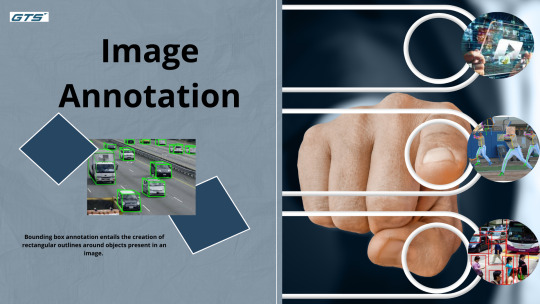
Introduction:
In the era of artificial intelligence and machine learning, image annotation is essential for enabling machines to perceive and comprehend the world in a manner akin to human understanding. This capability is vital for applications ranging from autonomous vehicles to facial recognition technologies and medical diagnostics, as the effectiveness of AI models in interpreting images is significantly dependent on the quality of the annotation provided.
What is Image Annotation?
Image Annotation refers to the practice of assigning metadata to images to facilitate the training of machine learning models. By identifying and labeling objects, regions, or characteristics within an image, annotation aids AI systems in recognizing patterns, distinguishing objects, and generating accurate predictions.
Various annotation techniques include:
Bounding Boxes: Enclosing objects within rectangles to assist AI in their detection.
Semantic Segmentation: Classifying each pixel in an image for detailed analysis.
Polygons and Key Points: Employed for identifying irregular shapes and landmarks in facial recognition tasks.
3D Cuboids: Assists AI models in grasping depth and the dimensions of objects.
Polyline Annotation: Utilized in lane detection for self-driving vehicles.
Why is Image Annotation Important?
Without adequately labeled data, machine learning models face challenges in effectively learning patterns. High-quality annotation guarantees:
Improved Accuracy: Superior training data results in more accurate AI predictions.
Enhanced Automation: Facilitates AI-driven automation across various sectors, including healthcare, retail, and transportation.
Safety and Reliability: Crucial for AI applications such as autonomous vehicles, where precision is paramount.
Types of Image Annotation Techniques
A variety of annotation techniques address distinct needs and complexities associated with image data.
Bounding Box Annotation
Bounding box annotation entails the creation of rectangular outlines around objects present in an image. This method is extensively utilized for object detection tasks, facilitating the identification and localization of objects within a scene. Bounding boxes are particularly advantageous for detecting objects with regular geometries and are computationally efficient for training models.
Semantic Segmentation
Semantic segmentation involves assigning a class label to each individual pixel in an image, which allows for a comprehensive understanding of the scene. This technique is vital for applications that demand precise localization, such as autonomous driving, where it is critical to differentiate between roads, sidewalks, and obstacles. Semantic segmentation offers pixel-level classification, enabling models to grasp the context and interrelations among various objects within an image.
Polygon Annotation
Polygon annotation consists of delineating objects with irregular shapes by utilizing a series of connected points to form a polygonal boundary. This approach provides enhanced accuracy for annotating complex objects compared to bounding boxes, as it closely adheres to the contours of the object. Polygon annotation is particularly useful for tasks that require precise object localization, such as in medical imaging and satellite imagery analysis.
Keypoint Annotation
Keypoint annotation identifies specific points of interest within an object, such as facial landmarks (eyes, nose, mouth) or joint positions in human pose estimation. This technique is crucial for applications like facial recognition, gesture recognition, and activity analysis, where understanding the spatial arrangement of key features is essential.
Cuboid Annotation
Cuboid annotation expands bounding boxes into three dimensions, offering depth information regarding objects.
Numerous sectors gain advantages from image annotation, such as:
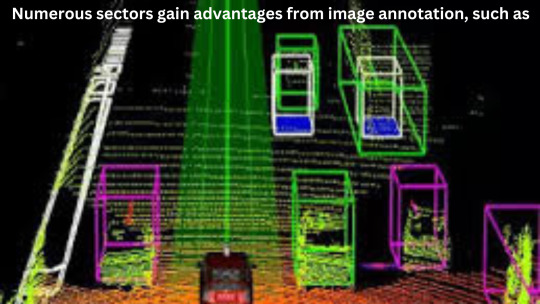
Healthcare: AI-driven diagnostics, tumor identification, and analysis of medical imaging.
Autonomous Vehicles: Lane identification, recognition of pedestrians, and detection of obstacles.
Retail and E-commerce: Visual search capabilities, product classification, and virtual fitting experiences.
Agriculture: Monitoring of crops, identification of pests, and forecasting of yields.
Selecting an Appropriate Image Annotation Partner
For organizations aiming to incorporate AI, collaborating with a specialized annotation service like GTS AI can significantly enhance outcomes. Professional annotation services offer:
Scalability: Efficient management of extensive data volumes.
Quality Assurance: Guaranteeing accurate and uniform annotations.
Security and Compliance: Safeguarding sensitive information through adherence to industry-standard security protocols.
Conclusion
Image annotation serves as the cornerstone of advancements in computer vision and AI. Whether engaged in medical AI, autonomous vehicle technology, or e-commerce solutions, high-quality annotation is crucial for optimal AI model performance. Investing in expert annotation services enables businesses to fully harness the potential of AI and maintain a competitive Globose Technology Solutions.
0 notes
Text
The Best Labelbox Alternatives for Data Labeling in 2025
Whether you're training machine learning models, building AI applications, or working on computer vision projects, effective data labeling is critical for success. Labelbox has been a go-to platform for enterprises and teams looking to manage their data labeling workflows efficiently. However, it may not suit everyone’s needs due to high pricing, lack of certain features, or compatibility issues with specific use cases.
If you're exploring alternatives to Labelbox, you're in the right place. This blog dives into the top Labelbox alternatives, highlights the key features to consider when choosing a data labeling platform, and provides insights into which option might work best for your unique requirements.
What Makes a Good Data Labeling Platform?
Before we explore alternatives, let's break down the features that define a reliable data labeling solution. The right platform should help optimize your labeling workflow, save time, and ensure precision in annotations. Here are a few key features you should keep in mind:
Scalability: Can the platform handle the size and complexity of your dataset, whether you're labeling a few hundred samples or millions of images?
Collaboration Tools: Does it offer features that improve collaboration among team members, such as user roles, permissions, or integration options?
Annotation Capabilities: Look for robust annotation tools that support bounding boxes, polygons, keypoints, and semantic segmentation for different data types.
AI-Assisted Labeling: Platforms with auto-labeling capabilities powered by AI can significantly speed up the labeling process while maintaining accuracy.
Integration Flexibility: Can the platform seamlessly integrate with your existing workflows, such as TensorFlow, PyTorch, or custom ML pipelines?
Affordability: Pricing should align with your budget while delivering a strong return on investment.
With these considerations in mind, let's explore the best alternatives to Labelbox, including their strengths and weaknesses.
Top Labelbox Alternatives
1. Macgence
Strengths:
Offers a highly customizable end-to-end solution that caters to specific workflows for data scientists and machine learning engineers.
AI-powered auto-labeling to accelerate labeling tasks.
Proven expertise in handling diverse data types, including images, text, and video annotations.
Seamless integration with popular machine learning frameworks like TensorFlow and PyTorch.
Known for its attention to data security and adherence to compliance standards.
Weaknesses:
May require time for onboarding due to its vast range of features.
Limited online community documentation compared to Labelbox.
Ideal for:
Organizations that value flexibility in their workflows and need an AI-driven platform to handle large-scale, complex datasets efficiently.
2. Supervisely
Strengths:
Strong collaboration tools, making it easy to assign tasks and monitor progress across teams.
Extensive support for complex computer vision projects, including 3D annotation.
A free plan that’s feature-rich enough for small-scale projects.
Intuitive user interface with drag-and-drop functionality for ease of use.
Weaknesses:
Limited scalability for larger datasets unless opting for the higher-tier plans.
Auto-labeling tools are slightly less advanced compared to other platforms.
Ideal for:
Startups and research teams looking for a low-cost option with modern annotation tools and collaboration features.
3. Amazon SageMaker Ground Truth
Strengths:
Fully managed service by AWS, allowing seamless integration with Amazon's cloud ecosystem.
Uses machine learning to create accurate annotations with less manual effort.
Pay-as-you-go pricing, making it cost-effective for teams already on AWS.
Access to a large workforce for outsourcing labeling tasks.
Weaknesses:
Requires expertise in AWS to set up and configure workflows.
Limited to AWS ecosystem, which might pose constraints for non-AWS users.
Ideal for:
Teams deeply embedded in the AWS ecosystem that want an AI-powered labeling workflow with access to a scalable workforce.
4. Appen
Strengths:
Combines advanced annotation tools with a global workforce for large-scale projects.
Offers unmatched accuracy and quality assurance with human-in-the-loop workflows.
Highly customizable solutions tailored to specific enterprise needs.
Weaknesses:
Can be expensive, particularly for smaller organizations or individual users.
Requires external support for integration into custom workflows.
Ideal for:
Enterprises with complex projects that require high accuracy and precision in data labeling.
Use Case Scenarios: Which Platform Fits Best?
For startups with smaller budgets and less complex projects, Supervisely offers an affordable and intuitive entry point.
For enterprises requiring precise accuracy on large-scale datasets, Appen delivers unmatched quality at a premium.
If you're heavily integrated with AWS, SageMaker Ground Truth is a practical, cost-effective choice for your labeling needs.
For tailored workflows and cutting-edge AI-powered tools, Macgence stands out as the most flexible platform for diverse projects.
Finding the Best Labelbox Alternative for Your Needs
Choosing the right data labeling platform depends on your project size, budget, and technical requirements. Start by evaluating your specific use cases—whether you prioritize cost efficiency, advanced AI tools, or integration capabilities.
For those who require a customizable and AI-driven data labeling solution, Macgence emerges as a strong contender to Labelbox, delivering robust capabilities with high scalability. No matter which platform you choose, investing in the right tools will empower your team and set the foundation for successful machine learning outcomes.
Source: - https://technologyzon.com/blogs/436/The-Best-Labelbox-Alternatives-for-Data-Labeling-in-2025
0 notes
Text
The Role of an Image Annotation Company in Enhancing AI Precision

Introduction
The effectiveness of Artificial Intelligence (AI) is fundamentally dependent on the quality of the data it processes, with Image Annotation Company being pivotal in elevating AI precision. Whether in autonomous vehicles, medical diagnostics, or online retail, AI systems require accurately labeled images to operate optimally. This is where an image annotation company can significantly contribute.
The Significance of Quality Image Annotation
For AI to accurately interpret and analyze visual information, it necessitates labeled images that convey valuable insights. High-quality annotations enable machine learning models to:
Precisely identify objects.
Distinguish between similar items.
Recognize anomalies in intricate settings.
Enhance decision-making based on real-world contexts.
Methods to Improve AI Precision
An image annotation company utilizes a variety of methods to boost AI precision, including:
Bounding Boxes: Essential for object detection, bounding boxes assist AI models in identifying and locating objects within images.
Semantic Segmentation: This technique divides an image into various regions, allowing AI to recognize distinct objects and comprehend contextual relationships.
Key Points and Landmark Annotation: Crucial for applications in facial recognition and pose estimation.
3D Cuboids: Employed in autonomous vehicles and robotics to facilitate depth perception and spatial awareness.
Polygon Annotation: For objects with irregular shapes, polygons provide detailed outlines, enhancing accuracy in object recognition.
The Impact of Image Annotation on AI Performance
AI models require extensive labeled data to refine their algorithms and reduce errors. By collaborating with an image annotation company, organizations can:
Improve Model Training: Well-annotated images accelerate AI learning and enhance accuracy.
Mitigate Bias in AI: Ensuring diverse and unbiased datasets fosters fairer AI predictions.
Boost Automation Efficiency: High-quality data annotations enhance the effectiveness of AI automation.
Industries Benefiting from Image Annotation
The demand for accurate image annotation is prevalent across various sectors:
Autonomous Vehicles – Self-driving cars powered by artificial intelligence depend on annotated images for tasks such as object recognition, lane detection, and identifying pedestrians.
Healthcare & Medical Imaging – Annotated medical images, including X-rays, MRIs, and CT scans, play a crucial role in diagnosing diseases and facilitating medical assessments.
Retail & E-Commerce – Features like product tagging and visual search enhance the online shopping experience for consumers.
Agriculture – AI-based solutions for monitoring crops, detecting pests, and predicting yields are supported by annotated images in the agricultural sector.
Why Collaborate with an Image Annotation Company?
Collaborating with a specialized image annotation company guarantees high levels of accuracy, consistency, and scalability. Professional annotation services offer:
Access to experienced annotators with relevant industry knowledge.
State-of-the-art annotation tools and rigorous quality control processes.
Scalable solutions capable of efficiently managing large datasets.
Conclusion
Artificial intelligence models significantly depend on well-annotated images to operate effectively. By partnering with a professional image annotation company, organizations can ensure their AI systems are equipped with high-quality data, resulting in enhanced accuracy, improved decision-making, and greater efficiency. Whether in healthcare, automotive, or retail, investing in superior image annotation is essential for realizing the full potential of AI.
How GTS.AI Make Your Project Complete?
Globose Technology Solutions is integral to our professional environment, offering high-quality, scalable, and accurate image annotation solutions that support AI models across various sectors. Its sophisticated annotation tools—including bounding boxes, semantic segmentation, and 3D cuboids—guarantee precision in training datasets for applications such as autonomous vehicles, healthcare diagnostics, and e-commerce. By utilizing AI-assisted annotation, automated quality control, and a proficient workforce, gts.ai improves efficiency, minimizes bias, and expedites AI development. Its cloud-based workflow facilitates seamless collaboration, enhancing the reliability and effectiveness of AI training, and ultimately influencing the future of intelligent automation.!
1 note
·
View note
Text
Image Data Annotation for Agriculture: Revolutionizing Crop Monitoring
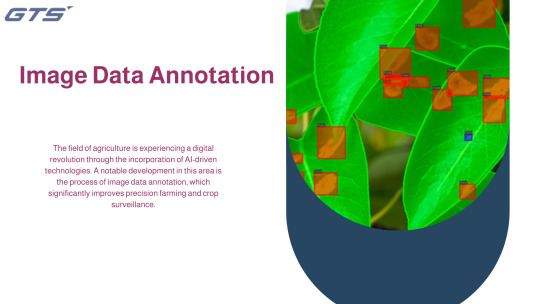
Introduction
The field of agriculture is experiencing a digital revolution through the incorporation of AI-driven technologies. A notable development in this area is the process of Image Data Annotation, which significantly improves precision farming and crop surveillance. Utilizing annotated images from agriculture, AI models are capable of assessing crop health, identifying diseases, and refining yield predictions.
What is Image Data Annotation in Agriculture?
Image data annotation in agriculture refers to the process of labeling visual information, including satellite imagery, drone captures, and photographs of fields, to facilitate the training of machine learning models tailored for agricultural purposes. These annotations enable artificial intelligence systems to detect patterns, classify crop types, and evaluate field conditions with a high degree of precision.
Categories of Image Data Annotation in Agriculture:
1. Bounding Box Annotation – This method identifies plants, weeds, and pests to enable automated detection.
2. Semantic Segmentation – This technique distinguishes between crops, soil, and weeds within an image.
3. Keypoint Annotation – This approach marks essential points on plants to monitor their growth.
4. Polygon Annotation – This method provides accurate outlines of fields and crop areas.
5. 3D Cuboid Annotation – This technique assists in estimating the height and structure of plants.
How Image Data Annotation is Transforming Crop Monitoring
1. Enhanced Crop Health Assessment
AI-driven models utilize annotated images to identify early indicators of diseases, nutrient shortages, and pest problems, allowing farmers to take timely action.
2. Identification of Weeds and Pests
Automated systems for weed detection leverage annotated datasets to differentiate between crops and harmful plants, minimizing the necessity for manual weeding and reducing pesticide application.
3. Yield Forecasting and Harvest Efficiency
Through the analysis of annotated images, AI models can project crop yields, enabling farmers to organize harvest timelines effectively and enhance overall productivity.
4. Targeted Irrigation and Soil Assessment
Image data annotation aids AI-based irrigation systems by monitoring soil moisture and plant hydration levels, promoting efficient water management.
5. Adaptation to Climate and Weather Changes
Utilizing annotated climate and weather data, AI models can foresee unfavorable conditions, assisting farmers in taking preventive actions against droughts or severe weather events.
The Importance of Professional Data Annotation Services
High-quality image annotation services, such as those offered by GTS AI, play a crucial role in the effective training of AI models. These services provide:
Scalability – The ability to manage extensive volumes of agricultural data with efficiency.
Accuracy – Superior annotations that enhance the precision of models.
Cost Efficiency – Minimizing manual labor expenses in the agricultural sector.
Customization – Bespoke annotation solutions tailored to meet specific agricultural requirements.
Conclusion
Image data annotation is revolutionizing the agricultural landscape by facilitating AI-driven crop monitoring, disease identification, and yield forecasting. As technological advancements continue, precision farming will further develop, equipping farmers with data-informed insights for sustainable agricultural practices.
For innovative image annotation solutions, consider GTS AI to transform your agricultural AI models today.
0 notes
Text
Unleashing the Power of Image Annotation: Transforming Industries

AI and ML development are revolutionizing the business and will leapfrog emerging technologies. Image Annotation One of the key elements that empower AI systems to achieve bug-free programming is image annotation. Image annotation is the technical act of labeling images to make visual data comprehensible to machines respectively. We are offering state-of-the-art image annotation services, with a focus on the precision and accuracy of AI models based on annotated datasets. The blog highlights what image annotation is, what applications it finds, and how GTS.ai specifies innovation in the sector.
What Is Image Annotation?
Image annotation is a major architect of computer vision, a subdivision of AI, permitting machines to analyze and interpret visual data across multiple points. The algorithm dictates that the images must have corresponding labels applied to them so that they can "see" and "understand" the visuals. The methods comprise various techniques ranging from bounding boxes, polygon annotations, semantic segmentation to 3D point clouds, depending on the sophistication of the application.
Why Image Annotation is Important
In one way or the other, image annotation is pretty crucial in shaping AI applications. Its importance comes to the fore:
Training Accurate AI Models :The pictures, which have been annotated, form a database to train AI algorithms. With data, the model predicts accurate objects and can even spot anomalies.
AI Applications across Domains : From self-driving cars to diagnosis in healthcare, annotated images present functional AI solutions that blend reliability and efficiency.
Drawing Insights from the Data : Annotated images help drive actionable insights across businesses, leading to better decision-making, enhanced customer experience, and improvement in operations.
Applications of Image Annotation in Various Industries
Autonomous Vehicles : Self-driving cars are very dependent on annotated datasets to recognize pedestrians, vehicles, traffic signs, and road conditions. With annotation done right, safety and functionality are guaranteed.
Healthcare : Annotated images allow AI to track diseases, tumors, or anomalies in X-rays, MRIs, and other diagnostic tools that assist doctors in making diagnoses more efficiently and precisely.
Retail & E-Commerce : Image annotation improves visual search engines, enabling customers to search for products using images. It also helps catalog products accurately.
Agriculture : AI-based drones analyze annotated images of farmland, tracking plant health and pest detection, as well as resource optimization.
Security and Surveillance : Annotated images allow for real-time facial recognition, intrusion detection, and activity monitoring.
Robotics : Robots trained with annotated images can sort items, assemble various components, and deliver packages with precision.
GTS.ai: Everything You Need in Image Annotation
At GTS.ai, we understand that quality annotated datasets contribute greatly to the accuracy of AI models. Our team of experts employs high-end and unique techniques in delivering image annotation services tailored to your project needs. So, what makes us stand out?
Various Annotation Methods : No matter if your project requires bounding boxes, polygon annotation, or even 3D labeling, we can manage them all.
Industry-Specific Know-how : Having worked across multiple industries, we understand your unique requirements and can deliver on what you desire.
Scalability and Flexibility : With GTS.ai, a project of any size and complexity will always be developed in-time without compromise of quality.
Data Security : Confidentiality of your data is paramount-at GTS.ai; stringent protocols of security will be adhered to.
Custom Solutions : Every project is different; so are our services. We offer customized annotation services, designed according to your specifications.
Why Work With GTS.ai?
When working with GTS.ai, you will definitely be dealing with a team that is all for perfection. So, this is how we add value to your AI journey.
Cost-effective Solutions: Quality services at a competitive price point.
Human-in-the-loop Model: Human annotation precision supplements the speed of AI-assisted tools.
Global Reach: Servicing clients across industries and geographies.
24/7 Support: Support is always dedicated toward addressing your queries and ensuring project needs are aptly executed. Future of Image Annotation
As the AI MLs develop progressively, so does the demand for high-quality image annotation. AI-powered automated tools and augmented reality annotators are all collectibles of these changes toward swifter and more accurate outcomes. GTS.ai is at the forefront of such improvements, continuously improving its service features to remain ahead of the curve.
Conclusion
Image annotation forms the bedrock of AI systems which have revolutionised whole industries and opened up new vistas of possibilities. GTS.ai prides in delivering excellent image annotation services, enabling firms to leverage the full potential of AI. In these lines, whether it is being done in the progressively evolving autonomous vehicles, health sector solutions, or retail optimized manifolds, we put our mark of experience upon the training of any oriented AI models.
Do you want to enhance your AI projects? Join hands with GTS.ai and watch how excellent image annotation produces a difference. To know more, check out GTS.ai!
0 notes
Text
#data annotation for autonomous vehicles#Image annotation company#3d bounding box annotation#annotation services in india
0 notes
Text
Best Image Annotation Companies Compared: Features, Pricing, and Accuracy

Introduction
As applications powered by artificial intelligence, such as self-driving cars, healthcare diagnostics, and online retail, expand, image annotation has emerged as a crucial component in developing effective machine learning models. However, with numerous providers offering annotation services, how can one select the most suitable Image Annotation Companies for their requirements? In this article, we evaluate several leading image annotation companies in 2025, considering their features, pricing, and accuracy, to assist you in identifying the best match for your project.
1. GTS.AI – Enterprise-Grade Accuracy with Custom Workflows
GTS.AI is renowned for its flexible annotation pipelines, stringent enterprise security standards, and its ability to cater to various sectors such as the automotive, healthcare, and retail industries.
Key Features:
Supports various annotation types including bounding boxes, polygons, keypoints, segmentation, and video annotation.
Offers a scalable workforce that includes human validation.
Integrates seamlessly with major machine learning tools.
Adheres to ISO-compliant data security protocols.
Pricing:
Custom pricing is determined based on the volume of data, type of annotation, and required turnaround time.
Offers competitive rates for datasets requiring high accuracy.
Accuracy:
Achieves over 98% annotation accuracy through a multi-stage quality control process.
Provides annotator training programs and conducts regular audits.
Best for: Companies in need of scalable, highly accurate annotation services across various industries.
2. Labelbox – Platform Flexibility and AI-Assisted Tools
Labelbox provides a robust platform for teams seeking to manage their annotation processes effectively, featuring capabilities that cater to both internal teams and external outsourcing.
Key Features
Include a powerful data labeling user interface and software development kits,
Automation through model-assisted labeling,
Seamless integration with cloud storage and machine learning workflows.
Pricing
Options consist of a freemium tier,
Custom pricing for enterprises,
Pay-per-usage model for annotations.
Accuracy
May vary based on whether annotators are in-house or outsourced, with strong quality
Control tools that necessitate internal supervision.
This platform is ideal for machine learning teams in need of versatile labeling tools and integration possibilities.
3. Scale AI – Enterprise-Level Services for Complex Use Cases
Scale AI is a leading provider in the market for extensive and complex annotation tasks, such as 3D perception, LiDAR, and autonomous vehicle data.
Key Features:
Offers a wide range of annotation types, including 3D sensor data.
Utilizes an API-first platform that integrates with machine learning.
Provides dedicated project managers for large clients.
Pricing
Premium pricing, particularly for high-complexity data.
Offers project-based quotes.
Accuracy:
Renowned for top-tier annotation accuracy.
Implements multi-layered quality checks and human review.
Best for: Projects in autonomous driving, defense, and robotics that require precision and scale.
4. CloudFactory – Human-Centric Approach with Ethical Sourcing
CloudFactory offers a unique blend of skilled human annotators and ethical AI practices, positioning itself as an excellent choice for companies prioritizing fair labor practices and high data quality.
Key Features:
The workforce is trained according to industry-specific guidelines.
It supports annotation for images, videos, audio, and documents.
There's a strong focus on data ethics and the welfare of the workforce.
Pricing
Pricing is based on volume and is moderately priced compared to other providers.
Contracts are transparent.
Accuracy
There are multiple stages of human review.
Continuous training and feedback loops are implemented.
Best for: Companies looking for socially responsible and high-quality annotation services.
5. Appen – Global Crowd with AI Integration

Appen boasts one of the largest international crowds for data annotation, offering extensive support for various AI training data types, such as natural language processing and computer vision.
Key Features
Include a diverse global crowd with multilingual capabilities,
Automated workflows, and data validation tools,
As well as high data throughput suitable for large-scale projects.
Pricing
Appen provides competitive rates for bulk annotation tasks,
With options for pay-as-you-go and contract models.
Accuracy
The quality of data can fluctuate based on project management,
Although the workflows are robust, necessitating a quality control setup.
Best for: This service is ideal for global brands and research teams that need support across multiple languages and domains.
Conclusion: Choosing the Right Partner
The ideal image annotation company for your project is contingent upon your specific requirements:
If you require enterprise-level quality with adaptable services, Globose Technology Solution.AI is recommended.
For those seeking comprehensive control over labeling processes, Labelbox is an excellent choice.
If your project involves intricate 3D or autonomous data, Scale AI is specifically designed for such tasks.
If ethical sourcing and transparency are priorities, CloudFactory should be considered.
For multilingual and scalable teams, Appen may be the right fit.
Prior to selecting a vendor, it is essential to assess your project's scale, data type, necessary accuracy, and compliance requirements. A strategic partner will not only assist in labeling your data but also enhance your entire AI development pipeline.
0 notes
Text
Image Annotation Services: Connecting Raw Data to AI Insights
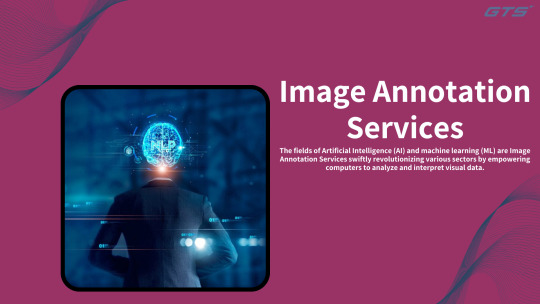
Introduction:
The fields of Artificial Intelligence (AI) and machine learning (ML) are Image Annotation Services swiftly revolutionizing various sectors by empowering computers to analyze and interpret visual data. However, unprocessed images do not offer the structured information necessary for AI to make precise decisions. This is where image annotation services become essential, serving as a link between unrefined image data and valuable AI insights.
Defining Image Annotation
Image annotation involves the process of tagging images with metadata to render them comprehensible for AI algorithms. These tags can identify objects, categorize images, delineate boundaries, or even monitor movements, depending on the specific needs of an AI model. Through accurate annotation, AI systems can identify patterns, recognize objects, and make well-informed decisions with a high degree of precision.
The Significance of Image Annotation for AI
AI models depend on extensive amounts of accurately labeled data for effective learning and enhancement. In the absence of proper image annotation, AI algorithms face challenges in differentiating between objects and accurately interpreting images. The following are some notable advantages of image annotation services:
Increased AI Precision: Well-annotated images facilitate more effective learning for AI, minimizing errors in object detection and classification.
Scalability in AI Development: A substantial volume of labeled data allows AI models to be trained to address a diverse array of real-world situations.
Enhanced Automation: From autonomous vehicles to healthcare diagnostics, annotated images empower AI to automate intricate tasks that necessitate visual recognition.
Improved User Engagement: Technologies such as facial recognition, augmented reality, and e-commerce product suggestions rely on high-quality image annotation to ensure a smooth user experience.
Types of Image Annotation Techniques
Various artificial intelligence applications necessitate distinct annotation techniques. Below are several prevalent types of image annotation utilized in AI training:
Bounding Box Annotation: This method is employed in object detection, where bounding boxes encapsulate objects within an image, facilitating AI in their recognition and classification.
Semantic Segmentation: This approach assigns a label to each pixel in an image, allowing for accurate identification of different areas.
Polygon Annotation: Unlike basic bounding boxes, polygon annotation offers detailed outlines of objects, resulting in more precise labeling.
Keypoint Annotation: This technique is utilized for facial recognition and human pose estimation, marking specific points on an object or human figure.
3D Cuboid Annotation: Vital for applications such as autonomous driving, 3D cuboids enable AI to comprehend depth and spatial relationships.
Applications of Image Annotation Across Industries
Image annotation services play a pivotal role in numerous AI-driven sectors. Some significant applications include:
Autonomous Vehicles: Training self-driving cars to identify pedestrians, traffic signs, and other vehicles.
Healthcare & Medical Imaging: Enhancing AI-based diagnostics through the labeling of X-rays, MRIs, and CT scans.
Retail & E-commerce: Supporting visual search and recommendation systems to improve the shopping experience.
Agriculture: Aiding in crop monitoring, disease detection, and yield estimation through AI-driven analysis.
Security & Surveillance: Enhancing facial recognition and anomaly detection for improved security systems.
Why Opt for Professional Image Annotation Services?
Although some organizations may choose to conduct annotation in-house, utilizing professional image annotation services presents numerous benefits:
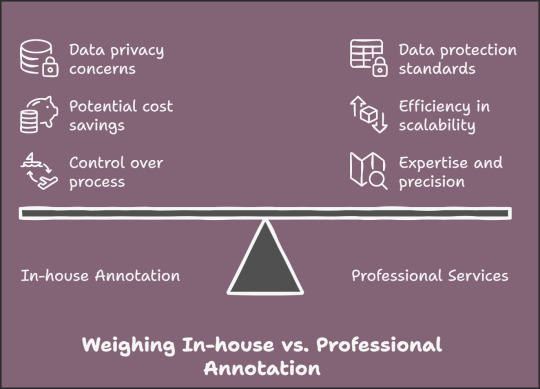
Expertise and Precision: Skilled annotators guarantee accurate labeling, which is crucial for optimal AI functionality.
Efficiency in Time and Costs: By outsourcing annotation tasks, companies can concentrate on AI development while minimizing operational expenses.
Scalability: Professional services are equipped to manage extensive datasets effectively, thereby expediting the AI training process.
Data Protection: Established annotation providers adhere to stringent data privacy standards, safeguarding the confidentiality of sensitive images.
Conclusion
Image annotation services play a vital role in the AI development process, converting unprocessed image data into organized, meaningful information. By connecting raw data with AI insights, these services enable businesses to create more intelligent and efficient AI models across diverse sectors. Whether applied in autonomous vehicles, healthcare, or retail, investing in high-quality image annotation services is a crucial step toward realizing the full potential of AI.
For further information on how image annotation can improve your AI initiative, please visit Globose Technology Solutions AI.
0 notes
Text
A Complete Guide to Choosing the Best Video Annotation Services

Introduction
Video Annotation Services serve as a fundamental component of contemporary artificial intelligence (AI) and machine learning (ML) applications, especially within the realm of computer vision. These services are essential for various applications, from facilitating autonomous vehicles to enhancing sophisticated surveillance systems, as accurately labeled video data is crucial for training AI models. Selecting an appropriate video annotation service can greatly influence the success of your AI initiatives. This guide aims to outline the essential considerations and factors to help you choose the most suitable provider for your requirements.
What Are Video Annotation Services?
Video annotation involves the labeling or tagging of elements within video content to generate structured datasets for AI and ML training. By recognizing objects, actions, and other visual components on a frame-by-frame basis, video annotation enables machines to comprehend and analyze dynamic visual information.
Applications of video annotation encompass:
Autonomous vehicles (object detection, lane tracking, pedestrian identification)
Video surveillance (detecting unusual behaviors or threats)
Healthcare (evaluating medical imaging and surgical procedures)
Retail (analyzing customer behavior)
Sports (tracking performance and analytics)
Why Are Video Annotation Services Important?
Video annotation services provide:
Accuracy: High-quality, precisely labeled data is essential for the effective performance of AI models.
Scalability: Professional services are equipped to manage substantial volumes of video data efficiently.
Expertise: Providers typically utilize advanced tools and skilled annotators to ensure accurate annotations.
Efficiency: Delegating annotation tasks allows organizations to save time and concentrate on their primary functions.
Explore GTS.AI Video Annotation Services to discover customized solutions tailored to your AI training requirements.
Considerations for Selecting Video Annotation Services
When selecting an appropriate video annotation service, it is essential to assess several key factors:
1. Expertise and Experience
Seek providers with a demonstrated track record in video annotation across diverse sectors. Evaluate:
Portfolio: Availability of case studies or examples of past projects.
Domain Knowledge: Understanding of the specific requirements pertinent to your industry.
Certifications: Compliance with industry standards and certifications that ensure data quality.
2. Annotation Techniques and Tools
Verify that the provider employs sophisticated annotation techniques and tools, including:
Bounding Boxes: Utilized for object detection.
Semantic Segmentation: For labeling at the pixel level.
3D Annotation: For capturing depth and spatial information.
Polygon Annotation: For objects with irregular shapes.
Skeleton Annotation: For estimating human poses.
Utilization of advanced AI-assisted tools can enhance efficiency and accuracy, minimizing manual labor.
3. Scalability
AI initiatives frequently involve extensive datasets. Opt for a provider capable of managing:
Large Volumes: Flexibility to scale operations according to project needs.
Quick Turnaround: Streamlined workflows to accommodate tight deadlines.
4. Data Security and Confidentiality
Ensuring data privacy is vital, particularly for sensitive projects. Confirm that the provider:
Implements robust data security protocols.
Agrees to non-disclosure agreements (NDAs) to safeguard your information.
Adheres to data privacy regulations such as GDPR or CCPA.
5. Quality Assurance
High-quality annotations are crucial for effective AI training. Look for:
Quality Control Processes: Implementation of multi-tiered reviews and validations.
Accuracy Rates: Providers that assure high levels of precision.
Error Handling: Systems in place for rectifying errors.
6. Cost-Effectiveness
Although cost is a significant consideration, it should not undermine the quality of the service. Assess the following:
Pricing Structures: Ensure pricing is clear and devoid of hidden fees.
Value Proposition: Achieve a harmonious balance between cost and quality.
7. Customization and Flexibility
Each project possesses distinct requirements. Select a provider that can offer:
Bespoke Solutions: Customized workflows and types of annotation.
Versatility: The ability to adapt to evolving project demands.
8. Communication and Support
Effective communication is vital for smooth collaboration. Seek out:
Dedicated Support Teams: Ready to assist with inquiries and provide updates.
Consistent Reporting: Mechanisms for tracking progress and receiving updates.
Collaborative Tools: Systems that facilitate real-time feedback and revisions.
Advantages of Collaborating with Professional Video Annotation Services
1. Time and Resource Efficiency
Delegating video annotation tasks enables your team to concentrate on essential AI development activities, thereby expediting project timelines.
2. Access to Expertise
Professional services utilize skilled annotators who guarantee high-quality results, even for intricate projects.
3. Improved Precision
Experienced providers utilize advanced tools and implement multi-tiered quality assurance processes to ensure accurate annotations.
4. Scalability
Professional services possess the capability to easily expand operations to accommodate the increasing demands of your project.
How to Assess Service Providers?
When selecting potential video annotation service providers, consider the following steps:

Request a Demonstration: Observe their tools and methodologies in practice.
Verify References: Seek client testimonials or reviews.
Initiate a Pilot Project: Evaluate their capabilities using a small dataset prior to engaging in larger assignments.
Compare Various Providers: Assess them based on the aforementioned criteria.
Conclusion
Selecting the appropriate video annotation service is essential for the development of effective AI models. By prioritizing expertise, scalability, data security, and quality assurance, you can ensure that your projects are supported by high-quality annotated data. Collaborating with trustworthy providers such as GTS.AI can enhance your AI initiatives with accurate and efficient video annotation solutions.
Make informed investments in the right service to position your AI systems for success in a data-driven future.
0 notes
Text
Video Annotation: Transforming Motion into AI-Ready Insights

AI and ML have changed the way people interact with digital content while video annotation is at the focal point of such transformation. It enables everything from detecting pedestrians by autonomous vehicles to real-time checking of threats in surveillance systems, but the interpretation of movement by artificial intelligence is highly dependent on high-quality annotated video data.
In simple terms, it is labeling video frames to add context for AI models. Annotated videos teach AI systems more effectively to identify underlying patterns, behaviors, and environments by marking objects, tracking movement, and defining interactions. Thus, they become smart, fast, and reliable decision-makers.
Why Video Annotation Matters in AI Development
The models that really grow from data are AI, and videos share much richer, dynamic information as compared to static images with no motion. It will provide motion, depth, and continuity, allowing AI to do things like:
Understand movement and object tracking in real-world environments.
Analyze complex interactions between people, objects, and the environment.
Improve decision-making in real-time AI applications.
Enhance accuracy by considering multiple frames rather than isolated snapshots.
These capabilities make video annotation essential for applications ranging from self-driving cars to sports analytics and healthcare diagnostics.
Types of Video Annotation Techniques
The efficiency of any AI model depends on the detail and number of techniques used to annotate the video. Each method caters to a particular type of AI, allowing the model to get exactly the type of data required in its learning process.
Bounding Box Annotation: This method involves drawing rectangular boxes around the objects identified in every frame. Bounding boxes provide an intuitive and effective training method for AI models to detect and recognize objects in the scene.
Semantic Segmentation: Semantic Segmentation is a more complex technique, but it involves the assignment of a category label for every pixel in the frame of a video. With semantic segmentation, the AI reaches a level of understanding of video content that matches that of a human, thus being able to better recognize objects.
Keypoint Annotation: This method usually annotates important points on an object for applications ranging from human pose analysis to face recognition AI. This annotation helps the AI understand body language and gesture by mapping joints and satellite trajectories.
Optical Flow Annotation: The optical flow technique tracks motion in terms of pixel displacement between two adjacent frames. It allows AI models to analyze past trajectories and ascertain the future possibilities of odors.
3D Cuboid Annotation: Unlike bounding boxes, 3D cuboids give depth perception, enabling AI to recognize object dimensions and spatial relationships. This annotation type ensures that AI understands object placement in three-dimensional space.
Challenges in Video Annotation
In spite of their tremendous advantages, video annotation has some annoyances that compromise AI model training farther on.
Huge Volume of Data: Videos contain thousands of frames, making annotation a small-scale arm-bending job. Streamlining the workflow with artificial or AI-assisted annotation could somehow help in this respect.
Motion Blur and Occlusion: Moving objects are magnificently difficult, if not next to impossible, to annotate. This is mainly because they can obscure themselves or become blurred by the movement. Some frame interpolation methods support increased annotation accuracy.
Data Privacy and Compliance: Video content may contain a lot of sensitive data from its very nature. Hence, it is subject to regulations of GDPR, CCPA, and the like. Such proper anonymization methods lead to ethical AI development in practice.
Annotation Consistency: Labeling must be consistent throughout frames and datasets. High variability leads to machine learning bias, so rigorous quality control is necessary.
The Future of Video Annotation in AI
Even as AI improves, techniques will change for video annotation. Various trends in motion analysis of video include:
AI-assisted annotation: Annotating objects with the assistance of AI in an automatic way and less manual effort.
Self-supervised learning: AI learns from unlabeled data off a video.
Real-time annotation: AI easily merges to the live video feed in real-time.
Federated learning: AI models trained over many sources from the edge of the client together, preserving privacy.
These developments will only increase the accuracy of AI, help ensure less training time for AI systems, and support enhanced AI application efficiency.
Conclusion
Video annotation is the backbone of AI-powered motion analysis, as they provide the training data required by machine learning models. With the ability to label objects, movements, and interactions correctly, AI systems can interpret and understand reality with improved accuracy.
From autonomous vehicles and healthcare to sports analytics and retail, video annotation is transforming industries and driving the path to AI innovation for the future. As annotation techniques develop, AI will continue to learn, adapt, and revolutionize the way we interact with visual data.
Visit Globose Technology Solutions to see how the team can speed up your video annotation projects.
0 notes
Text
Image Annotation: The Backbone of AI and Machine Learning
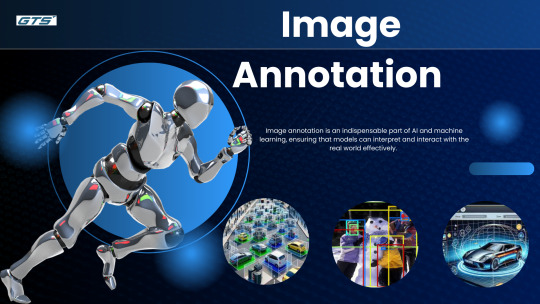
Introduction
Image Annotation serves as an essential component in the domains of artificial intelligence (AI) and machine learning (ML), facilitating the ability of machines to identify and interpret images with a level of accuracy akin to that of humans. This process is vital in various applications, ranging from autonomous vehicles to healthcare diagnostics, as it significantly contributes to the training of AI models in comprehending the visual environment.
What is Image Annotation?
Image annotation involves the systematic labeling of images with relevant metadata, thereby rendering them comprehensible to machine learning algorithms. These annotations enable AI models to detect objects, discern patterns, and recognize other features within an image. The precision of these annotations is crucial, as it directly influences the effectiveness of AI applications, underscoring its importance in the data preprocessing phase.
Types of Image Annotation
Various techniques are employed in image annotation, each designed for specific applications in artificial intelligence:
Bounding Box Annotation – This approach entails drawing rectangular boxes around objects, facilitating the detection and recognition of these objects by AI models. It is commonly utilized in object detection scenarios, such as identifying pedestrians in autonomous vehicles.
Semantic Segmentation – Rather than labeling entire objects, this technique assigns a class to each pixel within an image, enabling precise delineation of object boundaries. It is particularly beneficial in fields like medical imaging and satellite image analysis.
Keypoint Annotation – This technique involves marking specific points on objects, such as facial landmarks or human skeletal joints, which is essential for applications like facial recognition and pose estimation.
Polygon Annotation – In contrast to bounding boxes, polygon annotation offers more accurate representations of object outlines, making it suitable for identifying irregularly shaped objects, such as buildings in aerial photographs.
3D Cuboid Annotation – This method incorporates a three-dimensional perspective into objects, enhancing depth perception for AI models and aiding autonomous systems in better understanding their environment.
Polyline Annotation – This technique is utilized to indicate linear features, such as road lanes, thereby assisting self-driving vehicles in navigating effectively.
Applications of Image Annotation

Image annotation serves as a crucial element in various AI-driven sectors. Notable applications include:
Autonomous Vehicles – Self-driving technology utilizes annotated images to identify pedestrians, other vehicles, traffic signals, and potential hazards.
Healthcare – Medical AI applications leverage annotated images to identify diseases, support diagnostic processes, and improve interpretations in radiology.
Retail & E-commerce – Image recognition technology facilitates visual searches, enhances product recommendations, and streamlines automated checkout processes.
Security & Surveillance – High-quality image annotation is essential for facial recognition and anomaly detection in surveillance systems.
Agriculture – AI-enabled drones utilize annotated images of crops to evaluate health conditions and forecast yields.
Why Opt for Professional Image Annotation Services?
Manual image annotation is labor-intensive and demands a high level of accuracy. Companies such as GTS.AI focus on delivering superior image and video annotation services to guarantee precise training of AI models. Their proficiency in managing intricate annotation tasks aids businesses in optimizing AI development and enhancing model efficacy.
Conclusion
Image annotation plays a crucial role in the fields of artificial intelligence and machine learning, enabling models to accurately understand and engage with the real world. This process is vital across various applications, including autonomous vehicles, healthcare, and security, as high-quality image annotation contributes to the development of more precise and dependable AI systems. Engaging professional annotation services can greatly improve the performance of AI models, resulting in enhanced decision-making and automation capabilities.
For further information regarding image annotation services, please visit Globose Technology Solutions.
0 notes